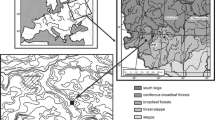Abstract
Herbaceous communities in forest ecosystems on the southern part of the Russian Plain appeared in the Middle Miocene (∼10 Ma BP). In the Late Miocene (∼7 Ma BP), feather-grass steppe associations appeared among them. In the time span of 2.7 to 2.1 Ma BP (i.e., in the Early Quaternary, according to the current chronostratigraphic scale), the steppe zone arose on the southern Russian Plain in the Don-Azov Region. Seven stages of this zone development here have been distinguished throughout the Quaternary. The first one (Eopleistocene-Early Pleistocene) was characterized by savanna-like subtropic ecosystems. Then, in the Middle Pleistocene, the temperate zone ecosystems (tallgrass prairie-like steppes) developed here and were followed by steppe ecosystems close to the modern ones in Central Europe. The ecosystems of rich-species forb steppes developed in the Late Pleistocene. Finally, in the optimum of the modern interglacial (Holocene), steppes became similar to the modern ones here, but with a slightly higher precipitation. The general trend is characterized by reduction in heat and water provision and increase in aridization progressing from earlier to later stages.
Similar content being viewed by others
References
Climate and Landscape Changes during the Last 65 Millions Years (Cenozoic: from Paleocene to Holocene), Ed. by A.A. Velichko (Geos, Moscow, 1999) [in Russian].
N. A. Lebedeva, Tr. Geol. In-ta AN SSSR, no. 84 (1963).
V. V. Titov, Large Mammals of Late Pliocene in the Northeast Near-Azov Region (Izd. YuNTs RAN, Rostov-on-Don, 2008) [in Russian].
Ivanov, I.V., Evolution of Soils of the Steppe Zone during the Holocene, (Nauka, Moscow, 1992) [in Russian].
A. A. Velichko, N. R. Katto, A. S. Tesakov, et al., Dokl. Akad. Nauk 429, 1364–1368 (2009).
A. A. Velichko, N. R. Katto, A. S. Tesakov, et al., in Present Situation and Technologies of Monitoring of Arid and Semi-Arid Ecosystems of the South of Russia (Izd. YuNTs RAN, Rostov-on-Don, 2010), pp. 52–64.
V. V. Semenov, in Paleomagnetism and Magnetism of Rocks: Theory, Practice, Experiment (IFZ RAN, Moscow, 2011), pp. 211–214.
Physiographic Atlas of the World, Ed. by I.P. Gerasimov (Izd. AN SSSR, Moscow, 1964) [in Russian].
V. A. Klimanov, in Climates and Landscapes of the Northern Eurasia in Conditions of Global Warming: Retrospective Analysis and Scenarios (Geos, Moscow, 2010), vol. 3, pp. 70–86.
Author information
Authors and Affiliations
Corresponding author
Additional information
Original Russian Text © A.A. Velichko, T.D. Morozova, O.K. Borisova, S.N. Timireva, V.V. Semenov, Yu.M. Kononov, V.V. Titov, A.S. Tesakov, E.A. Konstantinov, R.N. Kurbanov, 2012, published in Doklady Akademii Nauk, 2012, Vol. 445, No. 4, pp. 464–467.
Rights and permissions
About this article
Cite this article
Velichko, A., Morozova, T.D., Borisova, O.K. et al. Development of the steppe zone in southern Russia based on the reconstruction from the loess-soil formation in the Don-Azov Region. Dokl. Earth Sc. 445, 999–1002 (2012). https://doi.org/10.1134/S1028334X12080107
Received:
Published:
Issue Date:
DOI: https://doi.org/10.1134/S1028334X12080107




